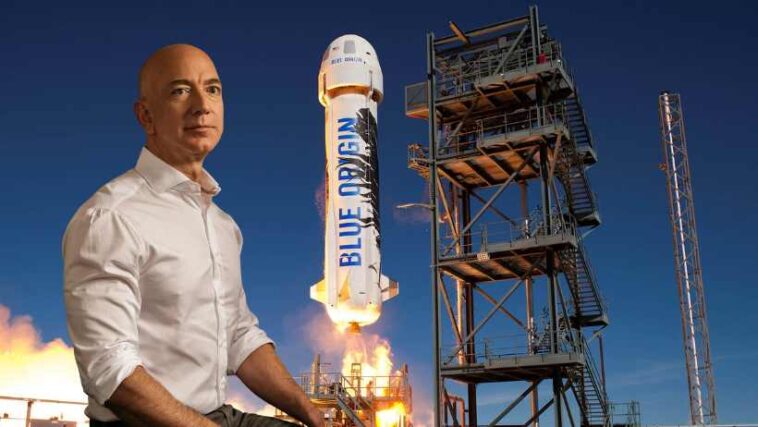Preparation for takeoff! Blue Origin is once again preparing to dominate the heavens, exactly one year after a rocket booster explosion halted their preparations. Ahead of time, an unmanned mission will embark, establishing a precedent for subsequent human space expeditions. With a scheduled launch window for the following week, the weather’s unpredictability is the only potential factor that could cause this thrilling event to be delayed.
A plethora of scientific knowledge and research, including contributions from NASA and universities in the United States, awaits aboard. Furthermore, an endearing total of 38,000 postcards, which have been handwritten by enthusiastic students, will also be en route. The final requirement is for the Federal Aviation Administration to grant its endorsement, subsequent to their inquiry into the prior error. Therefore, fasten your seatbelt and get ready for an exhilarating journey to outer space!
Blue Origin will resume flight following a rocket propellant detonation.
After a 15-month hiatus, Blue Origin, the aerospace corporation founded by Jeff Bezos, is preparing for its next launch. Regrettably, the previous endeavor came to an end as a result of a rocket propellant detonation. However, as a result of this incident, Blue Origin has implemented the required modifications and enhancements to guarantee a triumphant launch in the future.
In the background
Blue Origin experienced a setback with their previous launch failure; however, this has not deterred their determination. A 15-month-old incident precipitated a disruption in their planned launch schedule. Throughout this period, the Blue Origin team has been diligently striving to resolve the concerns that precipitated the detonation of the rocket booster.
Origin of the rocket propellant detonation
Blue Origin, after conducting an exhaustive investigation, has successfully identified the source of the rocket booster detonation. Specific elements, including a malfunctioning component and a propulsion system failure, were identified as contributing factors to the incident. Nevertheless, the Blue Origin team has implemented the requisite adjustments and enhancements to resolve these concerns and guarantee the prosperity and security of subsequent launches.
Forthcoming debut information
As the forthcoming launch will be an unmanned expedition, no personnel will be present on board. This mission plays a pivotal role in advancing Blue Origin’s overarching objective of launching human beings into outer space. Monday is the anticipated opening of the launch window; however, the precise time will be contingent on auspicious weather conditions.
Influence of weather conditions
The weather forecast for the impending launch is being closely monitored by the Blue Origin team, as it is critical to the success of any space mission. They recognize the critical nature of auspicious conditions and will initiate the launch solely when it is deemed secure to do so. If required, the team is ready to modify the launch window in order to guarantee optimal safety and achievement of the mission.
Participants and payloads
The forthcoming launch is scheduled to transport 33 scientific and research payloads in total. Contributions from NASA, universities in the United States, and other research organizations comprise these payloads. A wide array of experiments and studies will yield significant contributions to knowledge in numerous disciplines, including materials science, astrophysics, and biology.
The participation of NASA in this mission serves to underscore the synergy that exists between Blue Origin and the space agency. The collaboration facilitates the transfer of information and assets, which ultimately promotes the progress of scientific inquiry and exploration.
Students’ mementos amounting to 38,000 will be carried on the launch, alongside scientific payloads. The postcards serve as a representation of the youthful generation’s hopes and ambitions, thereby cultivating a sentiment of anticipation and motivation regarding the forthcoming era of space exploration.
FAA approval methodology
Prior to the commencement of the launch, authorization from the Federal Aviation Administration (FAA) is required. Thorough investigations are undertaken by the FAA in order to guarantee the safety and integrity of space launches. A thorough examination of the conclusions drawn from the prior unsuccessful launch has been underway, with close collaboration with Blue Origin to rectify any apprehensions.
Blue Origin maintains an optimistic outlook regarding the approval procedure, anticipating that it will be granted authorization to move forward with the launch. The FAA’s determination will be predicated on their evaluation of the enhancements and modifications implemented by Blue Origin, in addition to the safety protocols established to avert any unforeseen incidents.
Length of the hiatus
Due to the previous launch debacle, there has been a 15-month hiatus. The protracted cessation of operations enabled Blue Origin to conduct an exhaustive inquiry into the occurrence and enact the requisite modifications to preempt subsequent recurrences of the same nature. The duration of the suspension underscores Blue Origin’s commitment to ensuring safety and conducting thorough preparations.
The insights gained
Blue Origin derived significant insight from the launch failure that occurred previously. It brought to light the intricacies and difficulties associated with space missions, emphasizing the need for thorough testing and ongoing enhancement. Blue Origin is reassessing their procedures and implementing the required modifications in order to mitigate risks and guarantee the triumph of subsequent launches in light of the incident.
Components of the mission
The forthcoming mission holds considerable significance for Blue Origin. This unmanned mission is of utmost importance in advancing their objective of deploying human beings into outer space. Before embarking on crewed missions, they are able to test and refine their systems and procedures during this mission.
The mission’s objectives comprise a wide array of scientific inquiry. The payloads aboard will contribute significant data and insights, spanning from investigations into astrophysical phenomena to scans of microgravity’s impact on biological systems. We will gain a deeper understanding of the universe and scientific knowledge as a result of the mission’s accomplishments.
Status pending confirmation
The FAA’s sanction for the forthcoming launch is currently pending. The FAA is conducting a thorough examination of the enhancements and modifications implemented by Blue Origin in order to verify their safety and effectiveness for the mission. Although the exact timeframe for their determination has not been disclosed, Blue Origin maintains an optimistic outlook in anticipation of a favorable result.
In summary, Blue Origin is poised for another period of success subsequent to surmounting the obstacles presented by the prior rocket booster detonation. By means of thorough examination, adjustments, and enhancements, they have acquired significant knowledge and are presently prepared to commence a novel unmanned expedition.
This mission, characterized by its varied payloads and cooperative alliances, signifies a substantial advancement towards their overarching objective of achieving human spaceflight. Blue Origin anxiously awaits the FAA’s decision and is anticipating a prosperous launch that will bring them one step closer to their aspiration of establishing a prosperous spacefaring future.



